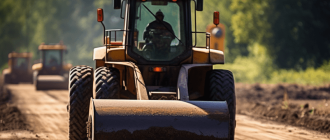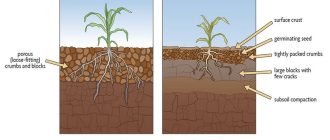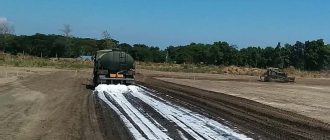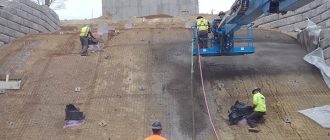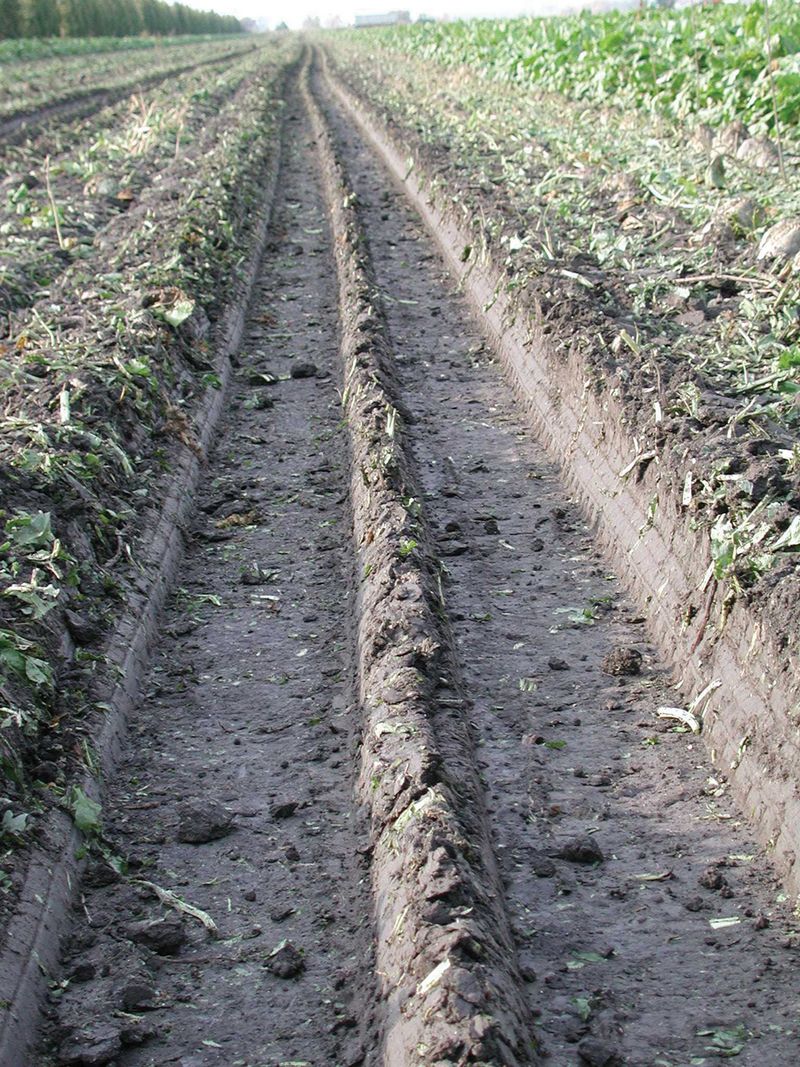
What is Soil Compaction?
Soil compaction is a critical factor that affects the overall health and productivity of a soil system. It refers to the process of reducing the pore spaces within the soil, resulting in a denser and more compacted structure. The structure and porosity of soil are essential for plant growth and development as they determine the soil’s ability to retain moisture and allow for root penetration.
One of the key consequences of soil compaction is a decrease in soil porosity, which directly affects the density and aeration of the soil. Porosity refers to the amount of space between soil particles, and it is vital for the movement of air and water within the soil. When soil becomes compacted, the pore spaces are reduced, limiting the movement of air and water, and ultimately affecting the growth of plant roots.
Soil compaction also influences the ability of roots to penetrate the soil. When soil is compacted, it becomes harder for roots to grow and spread, as they face resistance in their path. This can restrict the root’s ability to access essential nutrients and result in stunted growth and reduced yields.
Additionally, soil compaction affects the water-holding capacity of the soil. Compacted soils tend to have poor drainage, leading to waterlogged conditions and increased risk of root rot. On the other hand, when the soil is properly aerated and has good porosity, it allows for better water infiltration and drainage, ensuring plants have access to an adequate water supply.
In summary, soil compaction is a critical issue that affects the overall health and productivity of soil systems. It impacts the structure, porosity, density, aeration, penetration, and moisture-holding capacity of the soil, all of which are crucial for root growth and plant development.
What is Soil Compaction?
Soil compaction refers to the process in which the soil particles are pressed together, reducing the pore space and increasing its density. It occurs when external forces, such as heavy machinery, human activities, or natural processes, compress or squeeze the soil. This compression can lead to changes in the soil structure, root growth, and overall soil health.
The structure of the soil plays a crucial role in its ability to support plant growth. When the soil is compacted, the air and water channels within the soil are restricted. This reduction in pore space limits the movement of air, water, and plant roots. The compacted soil becomes more dense, resulting in reduced aeration, porosity, and nutrient availability.
Roots need space to grow and penetrate the soil effectively. In compacted soil, roots struggle to extend and establish a strong network, limiting the plant’s ability to acquire water and nutrients. This can lead to stunted growth, reduced crop yields, and increased susceptibility to diseases and pests.
| Reduced Aeration | Compacted soil restricts the movement of air, inhibiting the exchange of oxygen and carbon dioxide between the soil and the atmosphere. |
| Decreased Porosity | The compacted soil has reduced pore space, limiting the infiltration and movement of water, which can lead to drainage issues and increased erosion. |
| Poor Moisture Retention | Compacted soil has reduced water-holding capacity, making it difficult for plants to access and retain adequate moisture. |
| Restricted Root Growth | Compact soil hinders root penetration and proliferation, limiting the plants’ ability to access water, nutrients, and anchor themselves firmly. |
To identify soil compaction, various signs can be observed, such as the presence of hard, compacted layers, poor root development, surface crusting, increased runoff, and standing water in low-lying areas.
Preventing or mitigating soil compaction is crucial for maintaining healthy soils. Strategies such as reducing traffic on soil, avoiding working on wet soils, implementing proper drainage systems, practicing crop rotation, and using cover crops can help alleviate soil compaction and preserve soil structure and health.
The Effects of Soil Compaction on Plant Growth
Soil compaction refers to the process of increasing the density of soil, which can have significant impacts on plant growth. Compacted soil has a reduced ability for water penetration and air movement, leading to poor root development and limited nutrient availability.
One of the primary effects of soil compaction is the reduction in porosity, or the amount of space between soil particles. When the soil becomes compacted, the space between particles decreases, making it difficult for water, air, and roots to move through the soil. This lack of porosity inhibits root growth and can cause root deformation and reduced plant growth.
The structure of the soil is also affected by compaction. A compacted soil has less aggregation and smaller pore spaces. This results in a decreased ability for the soil to hold and exchange nutrients, leading to nutrient deficiencies in plants. Additionally, a compacted soil has reduced water-holding capacity, which can result in drought stress for plants.
Another critical impact of soil compaction is the hindrance of aeration. Compacted soil lacks sufficient air spaces, preventing oxygen from reaching plant roots. Oxygen is necessary for root respiration, which is essential for energy production within the plant. Without proper aeration, plants may exhibit stunted growth and reduced overall health.
Moisture distribution is also affected by soil compaction. Compacted soil has limited water infiltration and drainage properties, resulting in uneven moisture levels within the soil profile. Some areas may become waterlogged, leading to root rot and suffocation of plant roots, while other areas may experience drought stress.
- Reduced root development and deformation
- Nutrient deficiencies
- Drought stress
- Stunted growth
- Uneven moisture distribution
To mitigate the negative effects of soil compaction on plant growth, it is important to regularly monitor and manage soil compaction levels. Techniques such as deep tilling, aeration, and the use of organic amendments can help improve soil structure and promote healthy root growth. Implementing proper soil management practices is key to ensuring optimal plant growth and productivity.
Understanding the Relationship Between Soil Compaction and Water Drainage
Soil compaction refers to the compression of soil particles, reducing the space between them and decreasing soil porosity. This reduction in porosity can have a significant impact on water drainage within the soil.
Compacted soil has less space for water penetration, resulting in poor water drainage. When soil density increases due to compaction, the spaces between soil particles decrease, limiting the movement of water through the soil profile.
Soil porosity plays a crucial role in water drainage. Porosity refers to the amount of open space or voids in the soil. In compacted soil, porosity decreases, reducing its ability to absorb and hold water. This leads to surface runoff and waterlogging issues, preventing water from infiltrating into the soil.
Adequate moisture balance is vital for plants. Excessive water in compacted soil can make it difficult for plants to access oxygen, resulting in poor root development and hindering nutrient uptake. On the other hand, insufficient water drainage can lead to water stress and root asphyxiation.
Compacted soil also affects soil structure. Soil structure refers to the arrangement and organization of soil particles into larger aggregates. In compacted soil, the structure is degraded, resulting in smaller aggregates or clumps. This further reduces the ability of the soil to drain water properly.
Aeration is essential for plant root development and overall plant health. In compacted soil, the lack of proper aeration prevents the movement of air in and out of the soil. This can limit the availability of oxygen for the roots, leading to poor plant growth and decreased nutrient uptake.
To improve water drainage in compacted soil, it is essential to alleviate compaction. This can be done through various practices, such as soil aeration, organic matter addition, and reducing heavy machinery traffic on the soil. These practices help loosen the soil, increase porosity, and promote better water infiltration and drainage.
| Soil Density | Increases with compaction | Reduces water penetration and drainage |
| Soil Porosity | Decreases with compaction | Limits water absorption and retention |
| Moisture Balance | Excess water leads to waterlogging, while insufficient water affects plant growth | Affects root development and nutrient uptake |
| Soil Structure | Degraded in compacted soil | Reduces water drainage ability |
| Aeration | Restricted in compacted soil | Decreases oxygen availability for roots |
In conclusion, soil compaction has a direct impact on water drainage in the soil. Compacted soil reduces water penetration, limits porosity, affects moisture balance, degrades soil structure, and restricts aeration. Improving water drainage in compacted soil is crucial for ensuring healthy plant growth and sustainable agricultural practices.
How Soil Compaction Can Impact Soil Structure
Soil compaction refers to the compression of soil particles, which can have a significant impact on soil structure. When soil becomes compacted, it becomes harder and less porous, affecting its ability to support plant growth and maintain overall soil health.
One of the main ways soil compaction impacts soil structure is through its effect on root penetration. When soil is compacted, it becomes more difficult for roots to grow and spread. The compacted soil creates a dense barrier that roots cannot easily penetrate, limiting their access to essential nutrients and water.
Another way soil compaction affects soil structure is through its impact on moisture retention. Compacted soil has reduced porosity, meaning there are fewer spaces for water to infiltrate and be stored. As a result, water may drain more quickly through compacted soil, leading to poor water retention and potential drought stress for plants.
Compacted soil also has a negative effect on soil aeration, which is the exchange of gases between the soil and the atmosphere. When soil is compacted, the air-filled pores that allow for proper aeration are reduced. This can lead to a decrease in oxygen availability for plant roots and soil organisms, hindering their growth and overall soil health.
The impact of soil compaction on soil structure can be especially pronounced in agricultural and gardening practices. Heavy machinery and excessive foot traffic can contribute to soil compaction, making it more difficult for plants to thrive. It is important to take measures to prevent or alleviate soil compaction, such as avoiding excessive tilling, using cover crops, and implementing proper irrigation practices.
|
By understanding the importance of soil compaction and its impact on soil structure, we can take steps to prevent and mitigate its negative effects. Promoting soil health through practices such as regular soil testing, proper drainage, and incorporating organic matter can help maintain optimal soil structure and support healthy plant growth.
The Role of Soil Compaction in Nutrient Availability
Soil compaction refers to the process of increasing the density of soil particles, reducing the amount of pore space and porosity within the soil. This can have a significant impact on nutrient availability for plants and crops.
When soil becomes compacted, it becomes harder for water, air, and roots to penetrate the soil. The density of the soil increases, which restricts the movement of water and air, making it more difficult for plants to access the necessary nutrients.
One of the major consequences of soil compaction is the reduction in porosity. Porosity refers to the amount of space or voids in the soil, allowing for the movement of water, air, and plant roots. Compacted soil has fewer pore spaces, limiting the movement of water, which can result in poor drainage and waterlogging. This can lead to water stagnation and nutrient leaching, as excess water carries away essential nutrients before the plants can absorb them.
Root development is also affected by soil compaction. When soil is compacted, roots cannot penetrate deep into the soil to access water and nutrients. Shallow rooting limits the plants’ ability to explore a larger volume of soil, resulting in reduced nutrient uptake. This can ultimately lead to stunted growth and nutrient deficiencies in plants and crops.
Moreover, soil compaction can negatively impact soil structure. The compacted soil tends to have a uniform and dense structure, which hinders the formation of aggregates. Aggregates are clusters of soil particles that provide channels for water, air, and roots to move through. The absence of well-formed soil aggregates reduces the availability of nutrients as there are fewer pathways for nutrient movement and exchange.
Additionally, compaction can also affect soil moisture levels. Compacted soil has reduced infiltration rates, meaning it absorbs water at a slower rate. This can lead to water runoff, especially during heavy rainfall, causing the loss of nutrients along with the runoff water.
In conclusion, soil compaction plays a crucial role in nutrient availability for plants and crops. It affects the density, porosity, root development, soil structure, and moisture levels of the soil, all of which influence the ability of plants to absorb essential nutrients. Understanding the impact of soil compaction is vital for implementing proper soil management practices to ensure optimal nutrient availability and plant growth.
Methods for Measuring Soil Compaction
There are several methods available for measuring soil compaction. These methods can help assess the degree of compaction and determine the appropriate measures for soil improvement. Here are some commonly used methods:
- Penetration Resistance: This method measures the force required to penetrate the soil with a probe. Higher penetration resistance indicates higher soil compaction. A penetrometer is used to measure the resistance at different depths, giving an indication of the compaction level throughout the soil profile.
- Density Measurement: Soil density is measured using different techniques, such as the core cutter method or sand replacement method. These methods involve taking soil samples, measuring their volume, and determining the soil density by dividing the mass of the sample by its volume. Higher soil density indicates higher compaction.
- Visual Assessment: Visual assessments can provide a quick estimation of soil compaction. Signs of compaction include compacted soil layers, poor root development, plant stress, reduced water infiltration, and decreased soil porosity. However, visual assessment alone may not provide an accurate quantification of compaction.
- Aeration and Moisture: Soil compaction affects the movement of air and water within the soil, which can impact plant growth and root development. Monitoring soil aeration and moisture levels can help indicate the presence of compaction. Techniques such as measuring oxygen levels, monitoring water infiltration rates, or using tensiometers can provide insights into soil compaction.
- Porosity Measurement: Soil porosity refers to the amount of pore space in the soil. Compacted soil typically has lower porosity compared to well-structured soil. Porosity can be determined by measuring the volume of soil occupied by solids and comparing it to the total soil volume. Techniques like the bulk density method or the use of a porosity sampler can be employed.
By using a combination of these methods, soil scientists, farmers, and land managers can assess the level of compaction and make informed decisions about soil management practices. It is important to periodically monitor soil compaction to prevent detrimental effects on plant growth and overall soil health.
Factors That Contribute to Soil Compaction
Soil compaction occurs when there is excessive pressure exerted on the soil, causing the soil particles to pack tightly together. This can reduce the moisture and air within the soil, leading to detrimental effects on plant growth and overall soil health.
There are several factors that contribute to soil compaction:
-
Moisture: Soil compaction is more likely to occur in wet soils, as the water acts as a lubricant, allowing the soil particles to move closer together. This makes it easier for the soil to become compacted under the weight of machinery, livestock, or foot traffic.
-
Roots: The presence of roots can also contribute to soil compaction. As roots grow and spread, they can exert pressure on the soil, causing it to become compacted over time.
-
Soil structure: The structure of the soil plays a crucial role in its susceptibility to compaction. Soils with a high clay content are more prone to compaction, as the small clay particles can easily become compacted and reduce soil porosity and aeration.
-
Density: Soil density refers to the mass of soil per unit of volume. Soils with high density have more tightly packed soil particles, making them more susceptible to compaction. High-density soils are often found in areas with heavy foot or vehicle traffic.
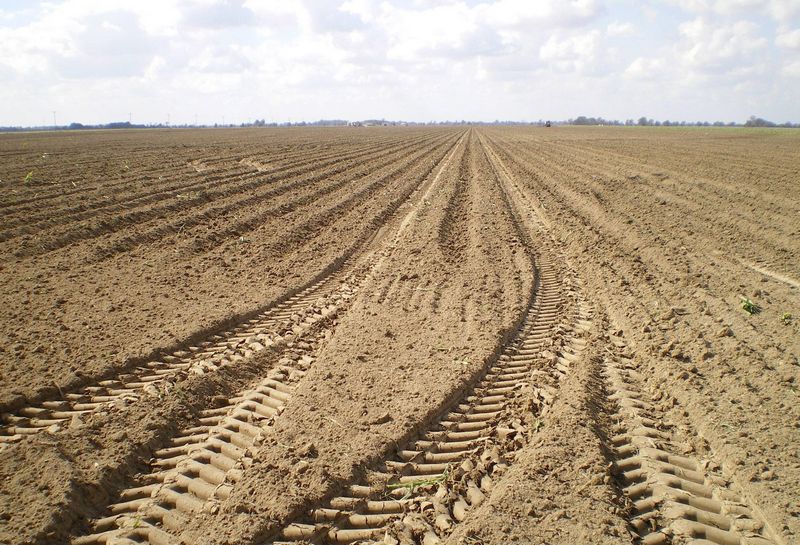
In summary, understanding the factors that contribute to soil compaction is crucial for maintaining healthy soil. By managing moisture levels, considering the impact of roots, improving soil structure, and monitoring soil density, it is possible to minimize the negative effects of compaction on plant growth and soil health.
The Importance of Proper Soil Preparation
Proper soil preparation is vital for the health and growth of plants. It plays a crucial role in the overall success of your gardening or agricultural endeavors. By ensuring that the soil is adequately prepared, you can create an optimal environment for plant growth, promote root development, and maximize crop yield.
One of the key aspects of proper soil preparation is addressing soil compaction. Compacted soil has reduced pore spaces, which restricts the movement of air, water, and nutrients in the soil. This can hinder root penetration and limit plant growth. By loosening compacted soil, you can improve its overall structure and porosity, allowing for better root growth and nutrient uptake.
Another important consideration in soil preparation is moisture retention. Well-prepared soil can effectively retain moisture, providing plants with a steady supply of water. This is crucial for plant health, as it helps prevent both under-watering and over-watering. Proper moisture levels in the soil also facilitate nutrient absorption by the roots, ensuring that plants can access the necessary nutrients for growth.
Aeration is another key element in soil preparation. Aeration involves creating channels or holes in the soil to improve air circulation and oxygen levels. Adequate oxygen in the soil is crucial for root respiration and nutrient uptake. By ensuring proper aeration, you can promote healthy root development, enhance soil fertility, and improve overall plant vigor.
Proper soil preparation also helps improve soil density. Approaches such as tilling or using organic matter can help break up compacted soil, resulting in a better soil structure. This allows for improved water infiltration, root penetration, and nutrient distribution throughout the soil profile. By achieving the right soil density, you can create an environment that supports robust plant growth and development.
In summary, proper soil preparation is of utmost importance when it comes to gardening or agriculture. By addressing soil compaction, promoting root development, ensuring adequate moisture retention, facilitating aeration, and improving soil density, you can create a favorable environment for plant growth. Invest time in preparing your soil, and you will reap the benefits of healthy and productive plants.
The Impact of Soil Compaction on Soil Erosion
Soil erosion is a serious problem that affects agricultural productivity and the environment. It occurs when the top layer of soil is removed or displaced due to factors such as wind, water, or human activities. One of the main factors that contribute to soil erosion is soil compaction.
Moisture plays a crucial role in soil erosion. When soil is compacted, its porosity decreases, which means that it can hold less water. As a result, when it rains, the water is not able to infiltrate into the soil properly and instead runs off the surface, increasing the risk of erosion. Additionally, compacted soil has a higher density, which further reduces its ability to absorb water. This leads to increased runoff and erosion.
The structure of the soil is also affected by compaction. Normally, soil is composed of aggregates or clumps that are held together by organic matter and root systems. However, when soil is compacted, these aggregates are broken apart, resulting in a loss of soil structure. The compacted soil becomes more prone to erosion as individual particles are more easily carried away by water or wind.
Soil compaction also affects soil penetration and aeration. Compacted soil has reduced pore spaces, making it difficult for plant roots to grow and penetrate the soil. This limits their ability to anchor the soil and protect it from erosion. Additionally, compacted soil has poor aeration, as the compacted particles restrict the movement of air through the soil. This can negatively impact the growth of beneficial soil organisms and lead to further degradation of the soil structure.
In conclusion, soil compaction has a significant impact on soil erosion. It reduces the soil’s ability to absorb and retain moisture, weakens its structure, and hinders root penetration and aeration. To mitigate soil erosion, it is important to take measures to prevent soil compaction, such as avoiding heavy machinery on wet soil and implementing proper soil management practices.
How Soil Compaction Affects Soil Temperature and Moisture
Soil compaction has a significant impact on the temperature and moisture levels of the soil. When soil becomes compacted, it loses its ability to retain moisture and regulate temperature effectively.
Aeration: Soil compaction reduces the amount of air in the soil, limiting aeration. Proper aeration is essential for root growth and nutrient uptake. When soils are compacted, the roots struggle to penetrate through the dense soil, resulting in poor root development.
Compaction and Root Penetration: Compacted soil increases the resistance that roots face during penetration. This decreases root penetration depth and restricts the ability of plants to access moisture deeper in the soil profile.
Soil Density: Compacted soil has a higher density, reducing the available pore space for water storage and movement. This results in poor drainage and increased runoff. When soil is unable to hold water, it can lead to water stress for plants and cause soil erosion.
Moisture: Compacted soil has a reduced ability to absorb and retain moisture. The decrease in porosity hampers water infiltration, making it difficult for plants to receive the necessary moisture for growth. This can result in water deficiencies and drought stress.
Porosity: Compacted soil has lower porosity, meaning it has fewer pore spaces available to hold water. This limits the soil’s ability to retain moisture and increases the likelihood of water runoff, further exacerbating the issue of water scarcity for plants.
In conclusion, soil compaction significantly affects soil temperature and moisture. It impedes aeration, restricts root penetration, increases soil density, and reduces moisture retention and porosity. Understanding the effects of soil compaction is crucial for managing soil health and ensuring optimal conditions for plant growth.
Preventing and Managing Soil Compaction in Agricultural Practices
Soil compaction is a common problem in agricultural practices that can greatly affect the productivity of crops. When the soil becomes compacted, it loses its ability to hold water and support plant growth. To prevent and manage soil compaction, farmers should consider the following practices:
- Proper Penetration: It is important to ensure that farm machinery and equipment do not pass over the same areas repeatedly. This reduces the pressure exerted on the soil, minimizing compaction.
- Maintain Soil Porosity: Soil porosity refers to the amount of open space or pores in the soil. Increasing soil porosity allows for better water infiltration and root penetration. This can be achieved by incorporating organic matter into the soil, such as compost or cover crops, which helps to improve soil structure.
- Regular Moisture Management: Adequate soil moisture is essential in preventing compaction. Moist soil is more pliable, making it less susceptible to compacting under the weight of machinery. Irrigation systems should be properly managed to ensure consistent moisture levels.
- Proper Soil Aeration: Soil aeration helps to alleviate compaction by allowing for the exchange of gases between the soil and the atmosphere. This can be achieved through practices such as deep tillage, subsoiling, or using specialized equipment like aeration machines.
- Encourage Deep Root Growth: Deep-rooted plants can help break up compacted soil layers. By encouraging the growth of deep-rooted crops, such as alfalfa or perennial grasses, farmers can promote soil structure improvement and reduce compaction.
- Monitor Soil Density: Regularly monitoring soil density can help farmers identify areas of compacted soil. Soil density can be measured using specialized tools or by assessing soil resistance to penetration. By identifying compacted areas, farmers can take targeted measures to alleviate compaction.
Implementing these practices can help prevent and manage soil compaction in agricultural practices. By maintaining proper soil structure, moisture levels, and encouraging deep root growth, farmers can improve soil health and ultimately increase crop productivity.
Implementing Best Practices for Soil Compaction in Construction
Soil compaction plays a crucial role in the success of construction projects. Proper compaction ensures that the soil beneath a structure provides the necessary support and stability. Implementing best practices for soil compaction can help prevent future issues stemming from soil settlement and movement. Here are some key practices to consider:
- Understand the soil: Before starting any construction project, it is important to understand the soil characteristics, including its root, porosity, structure, and composition. This information helps determine the appropriate compaction methods and equipment to use.
- Proper moisture content: Water plays a crucial role in compaction. The soil’s moisture content affects its ability to compact. It is important to maintain the right moisture content during compaction, as excessive moisture can lead to poor compaction and inadequate soil density.
- Choose the right compaction equipment: Different types of soil require different types of compaction equipment. Factors such as soil type, project size, and accessibility should be considered when selecting the appropriate compactor. Vibratory plate compactors, rollers, and vibratory rollers are commonly used for soil compaction.
- Proper compaction techniques: It is important to follow proper compaction techniques to achieve optimal results. Compaction should be performed in layers, with each layer properly compacted before adding the next. Adequate compaction ensures the soil has the desired density and strength.
- Monitor compaction density: It is crucial to monitor the compaction density during the compaction process. This can be done by conducting density tests, such as the Proctor test or the sand cone test, at regular intervals. Monitoring compaction density helps ensure that the desired level of compaction is achieved.
- Consider soil aeration: Soil aeration is an essential step in the compaction process. Aeration helps improve the soil’s porosity and allows for better penetration of water and nutrients. This can be achieved by using a soil aerator or by incorporating organic matter into the soil.
By implementing these best practices for soil compaction, construction projects can ensure that the soil beneath the structures is adequately compacted, providing the necessary support and stability. Proper soil compaction reduces the risk of soil settlement, erosion, and structural damage, ensuring the long-term success of the project.
The Role of Soil Compaction in Landscape Design and Maintenance
Soil compaction plays a crucial role in landscape design and maintenance. Understanding its impact on the health and growth of plants is essential for creating and maintaining a successful landscape.
Compaction: Soil compaction refers to the compression of soil particles, reducing the pore space between them. This compression can occur naturally or through human activities such as construction or heavy foot traffic.
Root Growth: Compacted soil inhibits root growth as it limits the ability of roots to penetrate the soil. Shallow root systems make plants more susceptible to stresses such as drought, disease, and temperature fluctuations.
Pore Space: Soil with adequate porosity allows for the free movement of air, water, and nutrients. Compacted soil greatly reduces the porosity and limits the availability of these essential elements.
Moisture Retention: Compacted soil has reduced infiltration rates, decreasing its ability to absorb and retain moisture. This can result in poor drainage, waterlogging, and increased runoff, adversely affecting plant health and growth.
Soil Density: Compacted soil has a higher density than loose, well-aerated soil. Higher soil density can restrict root penetration and hinder nutrient uptake by plants, leading to stunted growth and reduced overall plant health.
Penetration Resistance: Compacted soil has increased resistance to root penetration, making it difficult for plants to establish themselves. This can result in plants having shallow, weak root systems that are vulnerable to environmental stresses.
Soil Structure: Soil compaction disrupts the natural structure of soil, breaking down aggregates and reducing overall soil stability. The loss of soil structure can lead to erosion, decreased water-holding capacity, and decreased nutrient availability.
In landscape design and maintenance, it is crucial to address soil compaction to ensure the long-term health and success of plants. Regular soil testing, proper soil preparation before planting, and appropriate maintenance practices can help alleviate the negative effects of compaction and promote healthy plant growth.
Understanding Different Soil Types and Their Susceptibility to Compaction
Soil compaction is a common problem that can have negative effects on plant health and growth. It is important to understand the different soil types and their susceptibility to compaction in order to determine the best course of action for preventing or remedying compaction issues.
There are several factors that contribute to a soil’s susceptibility to compaction, including its root penetration, soil structure, porosity, moisture content, and density. Different soil types have varying characteristics that affect how easily they can become compacted.
- Sand: Sandy soils have large particles and low density, which means they are less susceptible to compaction. This type of soil allows for good root penetration and aeration, as it has high porosity. However, sandy soils also have low water holding capacity and can rapidly drain moisture, which may hinder plant growth.
- Clay: Clay soils have small particles and high density, making them more prone to compaction. They have low porosity and poor drainage, which can lead to waterlogged conditions and reduced root penetration. Despite these challenges, clay soils tend to retain moisture well and can provide good nutrients for plant growth if managed properly.
- Silt: Silt soils have medium-sized particles and moderate density. They have better water holding capacity than sand, but are more prone to compaction than sandy soils. Silt soils typically have good fertility and can support healthy plant growth if appropriate measures are taken to prevent compaction.
- Loam: Loam soils have a balanced mixture of sand, silt, and clay particles, making them ideal for plant growth. They have good porosity, drainage, and water holding capacity, while also providing adequate root penetration. Loam soils are less susceptible to compaction compared to clay or silt soils, making them highly desirable for gardening and agriculture.
It is important to note that soil compaction can occur in any soil type if the conditions are right, such as excessive heavy machinery or frequent foot traffic. Understanding the characteristics of different soil types can help in choosing appropriate soil management techniques and practices to prevent or alleviate compaction issues.
| Sand | Large | Low | High | Good | Low | Less susceptible |
| Clay | Small | High | Low | Poor | High | More susceptible |
| Silt | Medium | Moderate | Moderate | Moderate | Moderate | Moderately susceptible |
| Loam | Mixture | Balance | Good | Good | Balance | Less susceptible |
The Importance of Soil Compaction in Sports Field Management
Soil compaction plays a crucial role in sports field management. It refers to the process of increasing soil density by reducing its porosity. This can have a significant impact on the overall health and performance of the field.
One of the main reasons why soil compaction is important in sports field management is its effect on root growth. Compacted soil restricts root penetration and inhibits the development of a healthy root system. This can lead to weaker and less resilient plants, making the field more prone to damage and less able to withstand heavy use.
Another factor affected by soil compaction is the soil’s ability to hold and distribute moisture. Compacted soil has decreased porosity, which reduces its ability to hold water. This can result in poor drainage and waterlogged conditions, making the field more susceptible to diseases and compounding the issues caused by compaction.
Furthermore, soil compaction affects the overall soil structure. Compacted soil is denser and forms smaller particles, leading to reduced airflow and oxygen availability to plant roots. This can restrict microbial activity and nutrient uptake, further impacting the health and vitality of the sports field.
Sports field managers must prioritize soil compaction prevention and mitigation strategies. Regular monitoring and assessment of compaction levels are essential to identify problem areas and take appropriate action. Techniques such as aeration, vertical mowing, and the use of specialized equipment can help alleviate compaction and improve soil conditions.
In conclusion, understanding the importance of soil compaction in sports field management is crucial for maintaining high-performing and resilient fields. By prioritizing soil health and implementing proper compaction prevention and mitigation strategies, sports field managers can ensure the longevity and quality of their fields for the benefit of athletes and spectators alike.
The Role of Soil Compaction in Forestry and Silviculture
Soil compaction plays a crucial role in forestry and silviculture, affecting the overall health and productivity of forests. When soil becomes compacted, it becomes denser and firmer, which can have negative consequences for tree growth and development.
1. Reduced Soil Penetration: Compacted soil has a decreased ability to allow water, air, and roots to penetrate easily. This can lead to poor drainage, limited oxygen availability, and restricted root growth.
2. Impaired Aeration: Soil compaction reduces the natural air-filled spaces between soil particles, decreasing aeration and hindering the exchange of gases (such as oxygen and carbon dioxide) between the soil and the atmosphere. This can negatively impact soil microbial activity, nutrient availability, and overall soil health.
3. Altered Porosity: Compacted soil has less pore space, which affects both water movement and storage capacity. This can result in waterlogged conditions, preventing water from infiltrating into the soil or draining away properly, leading to poor soil moisture management for tree growth.
4. Disrupted Soil Structure: Soil compaction disrupts the natural arrangement of soil particles and aggregates, causing the soil to become more compacted and hard. This can make it challenging for tree roots to penetrate the soil and access essential nutrients and water.
5. Restricted Root Development: In compacted soil, tree roots struggle to grow optimally, limiting their ability to anchor trees securely and absorb nutrients and water from the soil. This can result in stunted growth, reduced tree vigor, and increased susceptibility to diseases and pests.
6. Impaired Moisture Management: Compacted soil hampers the movement of water within the soil profile. It can lead to uneven water distribution, increased runoff, and reduced water infiltration, subsequently affecting the availability of water to tree roots.
To mitigate the negative effects of soil compaction in forestry and silviculture, it is essential to employ soil management practices that prioritize soil health and minimize compaction. These practices can include minimizing heavy machinery use, implementing controlled traffic systems, practicing reduced tillage or no-till methods, and implementing techniques such as soil aeration and biological soil amendments.
Q&A:
What is soil compaction and why is it important?
Soil compaction is the process of compressing soil particles, reducing the pore spaces between them. It is important because compacted soil can negatively impact plant growth, crop yields, and overall soil health.
What are the causes of soil compaction?
Soil compaction can be caused by various factors such as heavy machinery or equipment usage, excessive foot or vehicle traffic, and improper tillage practices. Natural processes like rainfall and freeze-thaw cycles can also contribute to soil compaction.
How can soil compaction be identified?
Soil compaction can be identified through visual signs such as hard-packed soil, poor drainage, and the presence of standing water. Additionally, a soil compaction test can be conducted using a soil penetrometer to measure soil resistance.
What are the consequences of soil compaction?
Soil compaction can have several negative consequences. It can reduce soil aeration, limit root growth, hamper water infiltration, increase soil erosion, and decrease nutrient availability. These effects can lead to decreased crop yields and overall soil degradation.

